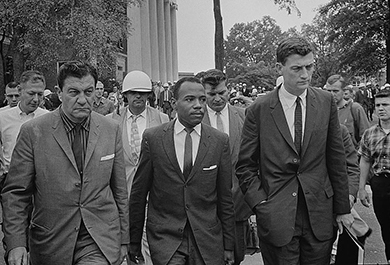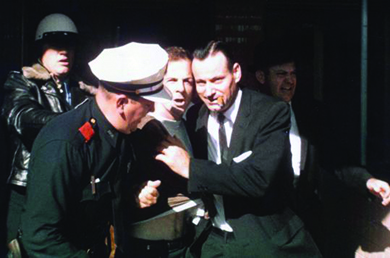| << Chapter < Page | Chapter >> Page > |
Cold War concerns, which guided U.S. policy in Cuba and Vietnam, also motivated the Kennedy administration’s steps toward racial equality. Realizing that legal segregation and widespread discrimination hurt the country’s chances of gaining allies in Africa, Asia, and Latin America, the federal government increased efforts to secure the civil rights of African Americans in the 1960s. During his presidential campaign, Kennedy had intimated his support for civil rights, and his efforts to secure the release of civil rights leader Martin Luther King, Jr., who was arrested following a demonstration, won him the African American vote. Lacking widespread backing in Congress, however, and anxious not to offend white southerners, Kennedy was cautious in assisting African Americans in their fight for full citizenship rights.
His strongest focus was on securing the voting rights of African Americans. Kennedy feared the loss of support from southern white Democrats and the impact a struggle over civil rights could have on his foreign policy agenda as well as on his reelection in 1964. But he thought voter registration drives far preferable to the boycotts, sit-ins, and integration marches that had generated such intense global media coverage in previous years. Encouraged by Congress’s passage of the Civil Rights Act of 1960, which permitted federal courts to appoint referees to guarantee that qualified persons would be registered to vote, Kennedy focused on the passage of a constitutional amendment outlawing poll taxes, a tactic that southern states used to disenfranchise African American voters. Originally proposed by President Truman’s Committee on Civil Rights, the idea had been largely forgotten during Eisenhower’s time in office. Kennedy, however, revived it and convinced Spessard Holland, a conservative Florida senator, to introduce the proposed amendment in Congress. It passed both houses of Congress and was sent to the states for ratification in September 1962.
Kennedy also reacted to the demands of the civil rights movement for equality in education. For example, when African American student James Meredith, encouraged by Kennedy’s speeches, attempted to enroll at the segregated University of Mississippi in 1962, riots broke out on campus ( [link] ). The president responded by sending the U.S. Army and National Guard to Oxford, Mississippi, to support the U.S. Marshals that his brother Robert, the attorney general, had dispatched.

Following similar violence at the University of Alabama when two African American students, Vivian Malone and James Hood, attempted to enroll in 1963, Kennedy responded with a bill that would give the federal government greater power to enforce school desegregation, prohibit segregation in public accommodations, and outlaw discrimination in employment. Kennedy would not live to see his bill enacted; it would become law during Lyndon Johnson’s administration as the 1964 Civil Rights Act.
Although his stance on civil rights had won him support in the African American community and his steely performance during the Cuban Missile Crisis had led his overall popularity to surge, Kennedy understood that he had to solidify his base in the South to secure his reelection. On November 21, 1963, he accompanied Lyndon Johnson to Texas to rally his supporters. The next day, shots rang out as Kennedy’s motorcade made its way through the streets of Dallas. Seriously injured, Kennedy was rushed to Parkland Hospital and pronounced dead.
The gunfire that killed Kennedy appeared to come from the upper stories of the Texas School Book Depository building; later that day, Lee Harvey Oswald, an employee at the depository and a trained sniper, was arrested ( [link] ). Two days later, while being transferred from Dallas police headquarters to the county jail, Oswald was shot and killed by Jack Ruby, a local nightclub owner who claimed he acted to avenge the president.

Almost immediately, rumors began to circulate regarding the Kennedy assassination, and conspiracy theorists, pointing to the unlikely coincidence of Oswald’s murder a few days after Kennedy’s, began to propose alternate theories about the events. To quiet the rumors and allay fears that the government was hiding evidence, Lyndon Johnson, Kennedy’s successor, appointed a fact-finding commission headed by Earl Warren, chief justice of the U.S. Supreme Court, to examine all the evidence and render a verdict. The Warren Commission concluded that Lee Harvey Oswald had acted alone and there had been no conspiracy. The commission’s ruling failed to satisfy many, and multiple theories have sprung up over time. No credible evidence has ever been uncovered, however, to prove either that someone other than Oswald murdered Kennedy or that Oswald acted with co-conspirators.
The arrival of the Kennedys in the White House seemed to signal a new age of youth, optimism, and confidence. Kennedy spoke of a “new frontier” and promoted the expansion of programs to aid the poor, protect African Americans’ right to vote, and improve African Americans’ employment and education opportunities. For the most part, however, Kennedy focused on foreign policy and countering the threat of Communism—especially in Cuba, where he successfully defused the Cuban Missile Crisis, and in Vietnam, to which he sent advisors and troops to support the South Vietnamese government. The tragedy of Kennedy’s assassination in Dallas brought an early end to the era, leaving Americans to wonder whether his vice president and successor, Lyndon Johnson, would bring Kennedy’s vision for the nation to fruition.

Notification Switch
Would you like to follow the 'U.s. history' conversation and receive update notifications?